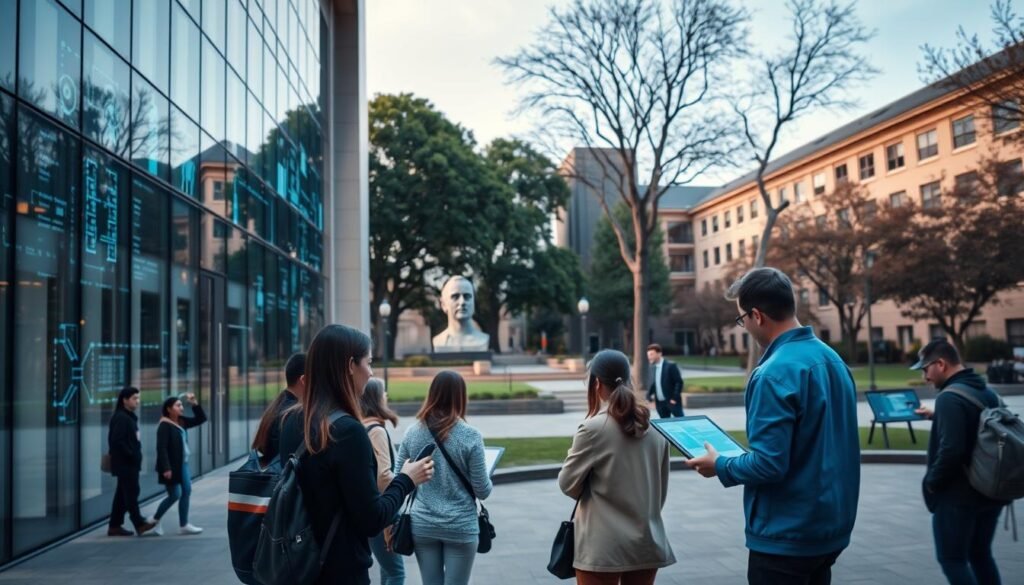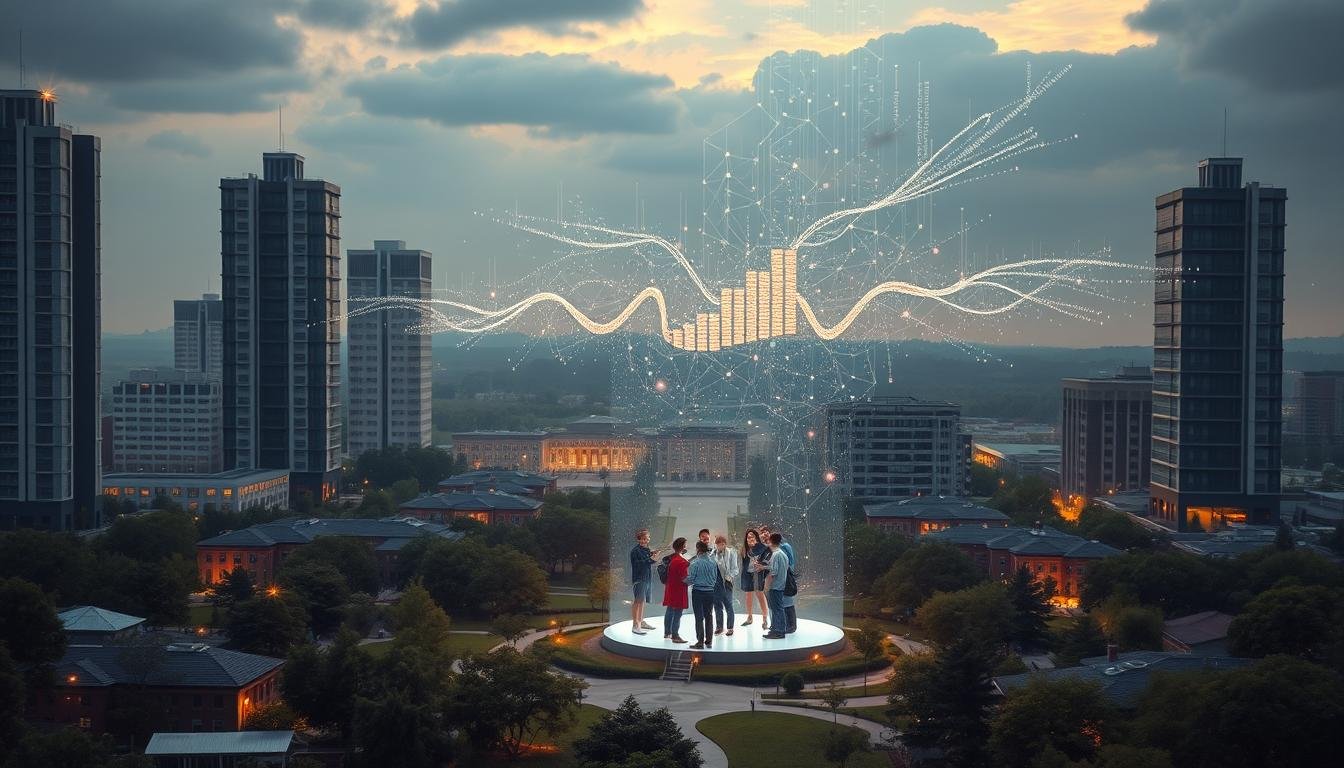Artificial intelligence is changing universities, affecting teaching, learning, and administration. This marks a big shift in higher education. AI is becoming more common in schools, aiming to better student results and learning experiences. As we look at AI in education, it’s clear that tech is playing a bigger role in schools.
Studies with 1113 participants show people are open to AI in schools. They see AI as a way to improve teaching, make things easier for administrators, and encourage new ideas. As we explore AI in education, we must think about its impact on universities and the future of tech in schools.
Key Takeaways
- AI is transforming the higher education landscape, with applications in teaching, learning, and administration.
- The rise of AI in higher ed: where we stand today is marked by an increase in AI-powered tool usage.
- AI in education has the potential to enhance teaching and learning, streamline administration, and foster innovation.
- Artificial intelligence in universities is driving higher education technology trends towards a more tech-savvy approach.
- The integration of AI in higher education requires consideration of ethical implications and privacy concerns.
- Studies have shown positive attitudes towards AI in higher education, with an anticipated increase in AI-powered tool usage.
- The recognition of AI’s potential to enhance teaching and learning is driving the adoption of AI in higher education.
The Current Landscape of AI in Higher Education
AI in academia is growing fast, with more uses and adoption. Schools are starting to see AI as a help, not a problem. This change will bring big improvements in teaching and learning.
Studies show that over 86% of college students use AI in their studies. Yet, 77% of education leaders think their schools are not ready for AI. They suggest using AI detection tools, but also need a bigger plan for keeping things fair.
Some important stats and adoption rates are:
- 33% of institutions have either begun or completed their efforts towards AI readiness
- 25% of institutions have plans to start their AI readiness efforts
- 41% of higher education leaders describe current AI policies and procedures as “extremely or somewhat permissive”
Creating AI literacy programs is expected. This will help both teachers and students grasp AI’s benefits and dangers. With big investments in AI, the future in schools looks bright.
Transforming Traditional Learning Models
Artificial intelligence is changing how students learn in universities. Machine learning in universities lets teachers give each student a tailored learning path. This makes learning better and helps students do well.
AI tools can spot students who might struggle early on. This way, teachers can help them sooner.
AI in education has brought new tools like AI chatbots and virtual assistants. These help teachers by doing some work for them. They also make learning more fun and give feedback right away. Studies show that using AI can make students’ grades go up by 0.3 to 0.7 points.
The good things about ai in education are:
* Better grades for students
* More fun learning experiences
* Learning is easier to get to
* Learning plans fit each student’s needs
* Quick feedback and ways to check progress
As artificial intelligence in universities gets better, it will change education a lot. AI makes learning personal, improves grades, and makes learning more fun. It’s making old ways of learning better and opening up new ways to learn.
AI-Powered Administrative Solutions
Higher education institutions are moving towards digital transformation in higher education to make their admin work better. They are using ai applications in educational institutions to make tasks easier and more efficient. A recent study found that 48% of higher education administrators haven’t used AI yet. This shows a big chance for growth and more use of AI.
AI can change how things work in higher education technology trends. For example, AI can look at campus data to make the best class schedules. This helps avoid conflicts and makes sure teachers have a fair load. AI chatbots can also help students by answering their questions quickly. They make applying and getting financial aid easier, and they help track who’s signing up.
- It makes things more efficient and productive
- It helps support students better
- It helps manage resources and plan better
As schools look into using AI more, they need to think about the challenges and limits. This way, they can use AI to bring new ideas and make things better for students. This will make the student experience even better.
The Rise of AI in Higher Ed: Where We Stand Today
AI is changing how universities work. About 100 universities have started offering AI-related credentials since ChatGPT came out. This shows ai applications in higher ed are growing fast. The future of ai in universities seems bright, with a 120% jump in AI degrees since 2011.
But, there are challenges of ai integration in education to face. Schools need to hire more staff and buy better computers for AI classes. For example, the University of Florida has added AI to many programs. Stony Brook University is spending $15 million on its AI project.
AI is making a big impact on education. It can make learning better and help with school tasks. But, we must tackle the challenges of ai integration in education to make it work well.
| Statistic | Value |
|---|---|
| Number of universities with AI-related credentials | 100 |
| Increase in AI-related degree conferrals since 2011 | 120% |
| Investment in AI initiatives by Stony Brook University | $15 million |
Enhancing Student Experience Through AI
Artificial intelligence is changing how students learn and interact with schools. Universities can now offer learning paths that fit each student’s needs. This makes sure every student can easily access and use educational content, helping those who need extra help.
Machine learning helps make sure digital platforms are accessible to everyone. It also helps students find the right degree and courses. This makes choosing what to study easier and more informed.
Some key benefits of ai in higher education include:
- Improved student outcomes through personalized learning
- Enhanced accessibility and inclusivity
- Streamlined administrative processes
- Increased efficiency and effectiveness in academic support services
As schools use more ai, it’s important to think about ethics. We must make sure ai supports fairness and academic honesty for all students.
The future of ai in education looks bright. As technology gets better, we’ll see more ways ai can help students.
| AI Application | Benefit |
|---|---|
| Personalized learning pathways | Improved student outcomes |
| Automated accessibility checks | Enhanced accessibility and inclusivity |
| AI-driven degree recommendations | Streamlined academic decision-making |
Research and Innovation Capabilities
The future of ai in higher ed is changing fast. Schools are spending a lot on research and new ideas. The impact of ai on education sector is big, making learning better and grades higher.
Some important stats show AI’s growth in schools:
- 40% of people say their schools will spend more on AI because of new tech.
- 75% of the value from AI will be in marketing, sales, and product development.
- 60% of schools using AI are now using gen AI.
Using technology in learning is changing how students learn. As AI in schools keeps growing, schools need to keep up. They must invest in new research and ideas.

In short, AI’s effect on schools is huge. Schools must be ready to change and grow. By investing in AI, schools can make learning better and students succeed more.
| Category | Percentage |
|---|---|
| Organizations using gen AI | 60% |
| Respondents expecting increased investment in AI | 40% |
| Total annual value from generative AI use cases | 75% |
Ethical Considerations and Privacy Concerns
Institutions must tackle the ethical and privacy issues that come with AI in higher education. AI raises questions about protecting data, ensuring fair access, and keeping academic integrity. It’s vital to use AI responsibly to keep trust in education.
AI can reflect biases in data, leading to unfair outcomes. For example, AI in lending can keep some groups from getting financial help. Schools must protect data and make sure AI is fair and equal.
Transparency and accountability in AI decisions are also key. As AI grows in education, clear rules for its use are needed. Students and teachers should know how AI is used and have a voice in its development. This way, AI can improve education without harming fairness or privacy.
Here are some steps to address these issues:
- Implementing robust data protection protocol
- Ensuring equitable access to ai-powered resources
- Promoting transparency and accountability in ai decision-making processes
By being proactive and responsible with AI, schools can make learning more inclusive and fair. This also supports the right use of AI in education.
Implementation Strategies for Universities
Universities looking to use ai must plan well. They need to check their tech setup, train teachers, and think about costs. This way, they can use new tech to improve learning and work better.
Important things to think about include:
- Upgrading computing infrastructure to accommodate future ai tools
- Preparing for increased bandwidth and lower latency on networks
- Managing unprecedented amounts of data generated by ai tools
- Providing faculty training and development to ensure effective use of ai
Using new tech like ai chatbots and virtual helpers can help. These tools can make learning more fun, offer tailored paths, and track how well students are doing. By using ai, universities can give students an edge in the job world.

To make ai work in schools, careful planning and teamwork are key. Universities must keep improving and learning. Together, they can make a better future for students.
| Benefits of Ai in Higher Education | Examples |
|---|---|
| Enhanced student engagement | AI-powered chatbots, virtual learning assistants |
| Personalized learning pathways | AI-driven adaptive learning systems |
| Improved academic performance tracking | AI-powered analytics and reporting tools |
Future Prospects and Emerging Trends
The future of ai in higher education is changing fast. New trends and prospects are shaping how schools work. Generative AI tools are becoming more common, with 49% of students and faculty using them regularly by September 2023.
Technology is changing education in big ways. AI is making learning better, making schools run smoother, and helping teachers with their research. This is making a big difference in how we learn and work in schools.
AI is becoming more important in schools. For example, 83% of K–12 teachers use AI tools for school work in 2023–2024. Also, 59% of teachers think at least one student has used AI for school. As AI keeps growing, schools need to keep up and adapt.
AI can make learning better and help schools work more efficiently. But, it also brings up big questions. How do we keep learning fair and honest? How do we handle cultural differences? It’s important for everyone to work together to make sure AI helps education in a good way.
Conclusion: Embracing the AI Revolution in Higher Education
The use of artificial intelligence in education is changing how schools work. It’s important for teachers, school leaders, and students to accept this change. Looking ahead, AI will be key in making learning better.
Studies show AI can find where students need help and suggest the right materials. It can also predict which students might struggle and offer help early. But, we must make sure AI doesn’t make things worse for some students.
Some good things about AI in schools include:
- Learning plans that fit each student
- Systems that grade work automatically, saving time
- AI feedback that lets teachers focus on more important tasks
- AI chatbots available 24/7 to help students
As schools start using AI, they must be open, responsible, and fair. This way, AI can help students learn better, make learning more enjoyable, and shape the future of education.
Final Thoughts on the Rise of AI in Higher Ed
The rise of artificial intelligence (AI) in higher education is changing how schools work and teach. Technology in learning, AI impact on universities, and higher ed innovation with AI are making a big difference in the future of schools.
AI brings both good and bad sides, but schools must get on board. Using AI tools can help students learn better, make school work easier, and make learning more fun.
But schools need to use AI wisely. They must think about ethics, keep data safe, and make sure everyone has a chance to use AI. This way, AI can help everyone and keep schools true to their values.
Looking forward, AI will keep changing schools. By keeping up with AI, listening to students and teachers, schools can use AI to make learning better for everyone.


Leave a Reply